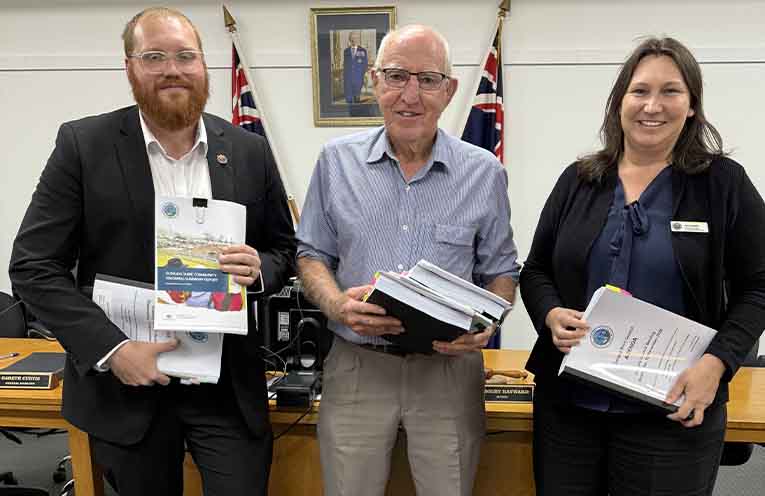DUNGOG Shire Council has endorsed a suite of major strategic planning documents to be placed on public exhibition under the Commonwealth Government-funded Housing Support Program – Stream 1.
The draft documents form the foundation of Council’s long-term growth management framework and have been developed to guide how the Shire will meet the NSW Government’s Housing 2041 strategy and Hunter Regional Plan 2041, which aims to address housing needs across the state and the region over the next 20 years.
Dungog Shire has been earmarked to deliver an additional 2400 homes as part of the state and region’s strategy.
Mayor Digby Rayward said the plans will guide our Shire for decades to come, while preserving what the community values most.
“These plans address where growth will occur, what infrastructure and services are needed to support growth, and the associated zoning, lot size requirements, and development types required to make it happen.
“Our Councillors and Council staff have been working incredibly hard to engage with the community to develop these strategies,” Mayor Rayward said.
“I hope the community takes this opportunity to review them and provide their feedback while they are on public exhibition.”
The draft documents on public exhibition include:
1. Draft Dungog Shire Local Strategic Planning Statement (LSPS)
Council’s 15-year vision for land use planning across the Shire. It sets priorities for how and where Dungog will grow, ensuring housing, infrastructure, environment, economic development, and community values are aligned in an integrated framework. The LSPS also brings together the findings of the housing, rural lands and infrastructure into one strategic direction for the Dungog Shire.
2. Draft Dungog Shire Local Housing Strategy
This draft Local Housing Strategy identifies the types of housing needed to support a growing and ageing population, strengthen affordability, and ensure housing growth occurs in the right locations. It provides a roadmap for housing diversity such as dual occupancies, secondary dwellings, seniors housing, and appropriately scaled infill housing – focusing growth in existing towns and villages while protecting rural landscapes.
3. Draft Dungog Shire Rural Lands Strategy
The draft Rural Lands Strategy provides a contemporary approach to managing the Shire’s agricultural and rural landscapes. It responds to community feedback about protecting rural character, enabling diversification for farmers, supporting agritourism and small-scale enterprises, and balancing opportunities for rural living, while protecting high-value farmland and biodiversity.
4. Draft Infrastructure Capacity and Prioritisation Plan
The draft Infrastructure Capacity and Prioritisation Plan identifies the infrastructure required to support future growth, including water, sewer, transport, open space, community facilities, and utilities. It outlines priorities for staged investment and ensures growth is aligned with servicing capacity so that infrastructure leads development rather than lags behind it.
5. Draft Dungog Strategic Centre Structure Plan & Streetscape Masterplan
The draft Structure Plan sets out the long-term vision for the Dungog Strategic Centre, guiding where new housing, community facilities, employment land, and transport connections will be located. The draft Streetscape Masterplan provides detailed designs for a greener, safer and more walkable town centre, featuring tree-lined streets, wider footpaths, safer crossings, improved cycling links, and beautified public spaces that reflect Dungog’s unique character and heritage.
The major outcomes identified in the strategies include:
● Dungog and Clarence Town are the primary focus for urban growth due to their proximity to shops, transport, services and schools
● Paterson, Vacy, Gresford, East Gresford and Martins Creek to experience incremental growth while respecting village character
● diverse housing achieved by applying new zone types (including R2 Low Density) to support appropriate densities
● reducing minimum lot sizes for RU1 (Primary Production) blocks from 60ha to 40ha
● RU2 (Rural Landscape) will have a 40ha minimum lot size to suit larger, extensive rural and community uses, while protecting working agricultural land
● introducing a new zoning category, RU4 for Primary Production Small Lots, with a 20ha minimum lot size in key ‘soil-rich’ areas in Vacy, Paterson and Martins Creek
● enabling ‘farming-plus’ diversification which supports agritourism, small-scale processing, farm stays and short-stay accommodation.
“This is a once-in-a-generation opportunity for the people of Dungog Shire to shape how our community grows and evolves, so it’s imperative we have the community review the documents and provide their feedback before they are endorsed by Council in early 2026,” Mayor Rayward said.
The documents can be viewed on Council’s website, with submissions accepted online, via email, or in writing before the public exhibition closes at 5pm on 21 December 2025.
Council will also be holding a series of drop-in information sessions so the community can come and find out first-hand the changes in their area.
Details of the sessions are also available on the Council’s website.
Council encourages all residents, landowners, business owners, and community groups to take part in this important process and help shape the future of Dungog Shire.



